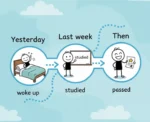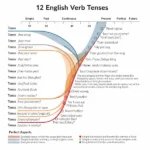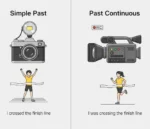Ticking Tock! Learn About Asking and Telling Time in English
Learning to tell time in a new language can feel a bit like cracking a secret code, but don’t worry! In this article, we’ll break down how to ask for and tell the time in English, step by step. We’ll use lots of examples, helpful charts, and even some pictures to make it super easy for you. Ready to be telling time like a pro? Let’s go!
Why is Telling Time Important?
Imagine you have a doctor’s appointment, a class, or a meeting with a friend. If you don’t know how to ask or tell the time, you might miss out! Learning this skill is essential for:
- Making plans: “Let’s meet at 7 PM!”
- Understanding schedules: “The train leaves at 3:15.”
- Following instructions: “Please finish this by 10 AM.”
- Everyday conversations: “What time is it?”
It’s a fundamental part of daily communication, and you’ll be using it all the time!
Asking “What Time Is It?”
There are a few common ways to ask about the time in English. Here are the most important ones:
- “What time is it?” (This is the most common and polite way.)
- “What’s the time?” (A slightly shorter, also very common way.)
- “Do you have the time?” (This is also polite and often used when you’re asking a stranger.)
- “Could you tell me the time, please?” (A very polite and formal way.)
Examples:
- You’re on the street and want to know the time: “Excuse me, what time is it?”
- You’re talking to a friend: “Hey, what’s the time? We need to leave soon.”
Understanding the Clock: The Basics
Before we dive into telling time, let’s look at the clock itself. We mostly use a 12-hour clock in spoken English, but sometimes you’ll see a 24-hour clock (especially for official schedules like trains or planes).
The 12-Hour Clock: AM and PM
The 12-hour clock divides the day into two 12-hour periods:
- AM (Ante Meridiem): From midnight (12:00 AM) to noon (12:00 PM). This is the morning.
- PM (Post Meridiem): From noon (12:00 PM) to midnight (12:00 AM). This is the afternoon, evening, and night.
Think of it like this:
- Early morning: 6:00 AM (the sun is rising)
- Afternoon: 3:00 PM (after lunch)
- Evening: 7:00 PM (dinner time)
- Night: 11:00 PM (getting ready for bed)
Here’s a visual to help:

The 24-Hour Clock (Military Time)
Sometimes, especially in official contexts, you’ll see the 24-hour clock (also known as military time). This avoids the need for AM/PM because each hour has a unique number from 00 to 23.
- 1 PM is 13:00
- 2 PM is 14:00
- 6 PM is 18:00
- 10 PM is 22:00
While it’s good to recognize, you’ll mostly be using the 12-hour clock with AM/PM in everyday conversation.
Telling Time: Step by Step
Now for the fun part! There are two main ways to tell the time in English:
- “O’clock” and “It’s [Hour] [Minute]” (Simpler, more common for beginners)
- Using “Past” and “To” (More traditional and widely used)
Let’s look at each.
1. The Easy Way: “O’clock” and “It’s [Hour] [Minute]”
This method is very straightforward for telling time.
For exact hours (no minutes):
We use “o’clock” when the minute hand is on the 12.
- It’s 1:00 = “It’s one o’clock.”
- It’s 5:00 = “It’s five o’clock.”
- It’s 10:00 = “It’s ten o’clock.”
For hours and minutes:
Simply say the hour, then the minutes. This is very common and easy to understand.
- It’s 3:10 = “It’s three ten.”
- It’s 7:25 = “It’s seven twenty-five.”
- It’s 11:45 = “It’s eleven forty-five.”
Special Cases:
- 00 minutes after the hour (e.g., 8:00): You can say “eight o’clock” or sometimes “eight hundred” (especially when reading digital time).
- 0 minutes (e.g., 5:05): You say “oh” for the zero. So, 5:05 is “It’s five oh five.”
- 10:01: “Ten oh one.”
- 12:08: “Twelve oh eight.”
Here’s a quick chart:
| Digital Time | Spoken English (Easy Way) |
| 1:00 | One o’clock |
| 4:00 | Four o’clock |
| 2:15 | Two fifteen |
| 6:30 | Six thirty |
| 9:05 | Nine oh five |
| 12:55 | Twelve fifty-five |
2. The Traditional Way: Using “Past” and “To”
This method is also very common, especially for analog clocks. It describes how many minutes past the hour it is, or how many minutes to the next hour it is.
Imagine the clock face:
- Minutes 1-30 (left side of the clock, going clockwise from the 12 to the 6): We use “past” (or “after”).
- Minutes 31-59 (right side of the clock, going clockwise from the 6 to the 12): We use “to” (or “of” in some regions, but “to” is more common).
Let’s break it down:
A. Using “Past” (for minutes 1-30)
- Format: “It’s [minutes] past [hour]”
- Example: For 2:10 (10 minutes after 2) = “It’s ten past two.”
- Example: For 5:20 (20 minutes after 5) = “It’s twenty past five.”
B. Using “To” (for minutes 31-59)
- Format: “It’s [minutes until the next hour] to [next hour]”
- Example: For 2:50 (10 minutes until 3) = “It’s ten to three.”
- Example: For 5:40 (20 minutes until 6) = “It’s twenty to six.”
Special Phrases:
- Quarter past: For 15 minutes past the hour.
- 2:15 = “It’s a quarter past two.”
- 7:15 = “It’s a quarter past seven.”
- Half past: For 30 minutes past the hour.
- 2:30 = “It’s half past two.”
- 7:30 = “It’s half past seven.”
- Quarter to: For 15 minutes until the next hour.
- 2:45 (15 minutes until 3) = “It’s a quarter to three.”
- 7:45 (15 minutes until 8) = “It’s a quarter to eight.”
Here’s a chart to summarize “past” and “to”:
| Digital Time | Spoken English (Traditional Way) |
| 1:00 | One o’clock |
| 1:05 | Five past one |
| 1:15 | A quarter past one |
| 1:20 | Twenty past one |
| 1:30 | Half past one |
| 1:35 | Twenty-five to two |
| 1:45 | A quarter to two |
| 1:50 | Ten to two |
Let’s look at another image to help visualize “past” and “to” on a clock:

When to Use Which Method?
Both methods are correct and widely understood.
- For beginners, the “It’s [hour] [minute]” method is often easier because you just read the numbers. Many native speakers use this, especially for digital times or when they want to be very clear.
- The “past” and “to” method is more traditional and gives your English a more natural, fluent sound. It’s great to learn once you’re comfortable with the basics.
Pro Tip: Don’t stress too much about which method to use! The most important thing is to be understood.
Common Expressions Related to Time
Beyond just telling the time, here are some useful phrases:
- “On time”: Exactly at the scheduled time. “The train arrived on time.”
- “In time”: Early enough. “We arrived at the airport in time for our flight.”
- “Early”: Before the scheduled time. “She woke up early this morning.”
- “Late”: After the scheduled time. “He was late for work.”
- “At [specific time]”: “Let’s meet at 7 PM.”
- “Around [time]”: Approximately. “I’ll be home around 6 o’clock.”
- “Sharp”: Exactly at that time, no later. “The meeting starts at 9 AM sharp.”
Practice Makes Perfect!
The best way to learn is to practice!
- Look at your clock or phone: Every time you check the time, try to say it out loud in English using both methods.
- Ask others: When you’re with English speakers, ask “What time is it?” and listen to their answer.
- Listen to native speakers: Pay attention to how people on TV, in movies, or podcasts tell the time.
- Set reminders: Practice saying your alarm times in English.
You’ll get the hang of it quicker than you think!
Here is a PDF worksheet you can download for practicing telling the time. The answers are on a separate page.
Additional Helpful Links
- Study about time with your daily routine – Daily Routine: English Vocabulary for Beginners
- Learn more about how to use English punctuation – English Punctuation Guide for Beginners: Rules & Examples
Authoritative Resources for Further Learning
- British Council LearnEnglish: Provides excellent resources for English learners, including listening exercises for telling time.
- BBC Learning English: Offers a wide range of free materials, including videos and articles on everyday English.
- Cambridge English: Offers free activities and resources to help you practice your English.
Learning to tell time is a crucial step in becoming more confident in English. Keep practicing, and you’ll soon be telling the time like a native speaker!




